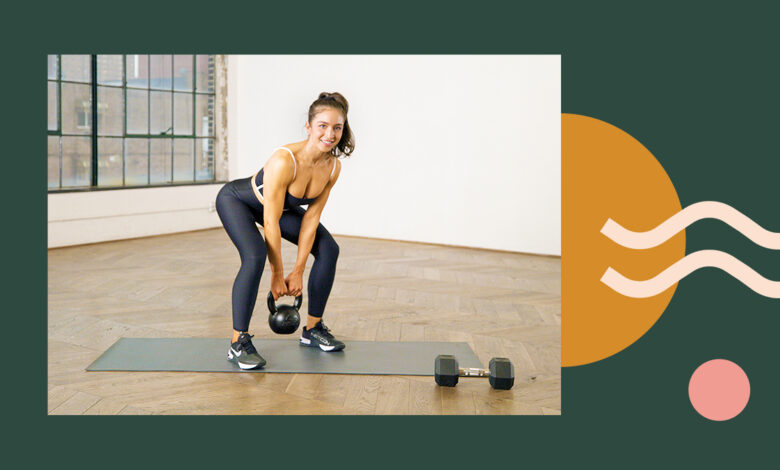Slow Strength Training Can Make Up for Light Weights

For years, my pasta jars served double duty: Before they, you know, sauced up my pasta, they’d serve as my at-home dumbbells. Their thick shape didn’t make them the easiest to grab, but they did the trick for the online barre classes I loved.
The one issue? At 24 ounces, they only gave me a pound and a half of weight to work with. Sometimes, it was enough, but for other exercises, it made it far too easy for me to phone it in on my sets.
Even today, now that I’ve gone fancy and upgraded to a couple of pairs of actual dumbbells, I don’t always have one heavy enough for a given strength workout. So, when I’m feeling spicy, I’ll try to increase the challenge by tacking on a few more reps or an extra set.
But in the latest episode of Well+Good’s “Good Moves” series, Roxie Jones, a strength trainer with Alo Moves, suggests another strategy: Slowing down.
“Going a little slower is going to make it harder,” she says. “If you’re not working with a lot of weight at home…one way to progress an exercise is to go a little bit slower and to hang on to tension.”
Science backs her up: A study in the Journal of Physiology found that moving slowly during leg extensions spurred more muscle growth than doing that same movement quickly. That’s likely because by slowing things down, you’re increasing the time that a muscle is contracting during a set. It also ensures you’re not just using momentum to move the weight—you have to control all movements (and lack of movements) with your muscles.
“It requires that you are enforcing the proper movement mechanics and that you are engaging things in the correct way,” Thea Hughes, a Brooklyn-based strength training coach and founder of Max Effort Training, previously told Well+Good. “This brings mind-body awareness into our workouts instead of just going through the motions.”
I can feel this in action firsthand as I follow along with Jones’ 18-minute standing workout for the legs. She uses one medium-weight dumbbell and a heavier kettlebell, though I just grab one 5-pound and one 8-pound dumbbell, since that’s what I’ve got.
Jones starts up with a light warmup to activate the major leg muscles. With my 5-pounder in hand, I notice that the slower I go through the Romanian deadlifts and lateral lunges, the more I feel those little fibers firing in my hamstrings, glutes, and quads.
But I realize the effects of my slow-mo work most of all during an active recovery move. Between supersets of deadlifts and reverse lunges, Jones programs 30 seconds for an alternating goblet march (basically, marching in place while holding the dumbbell in front of you and bringing the knees up high). A few seconds in, she recommends holding the knee at the top for a brief moment before returning that foot to the ground. As soon as I add that little pause, I feel the difficulty kick up a notch as the muscles in my core, legs, and upper back work to hold my balance (and the dumbbell!).
However, as with most things in life, this is not a hard-and-fast rule. Slower is not always better. Certain exercises call for quick or explosive movements.
Case in point: Jones uses the last five minutes of the class to work on kettlebell swings. (Don’t worry—she explains how to use a dumbbell for this portion if that’s all you have. And yes, a pasta jar could even work, too.) This is a move that’s all about building power and explosiveness, so going slow isn’t going to serve you.
If you’re concerned about what tempo to use for each exercise, don’t fret. Just play around with a few speeds, and your muscles will tell you everything you need to know about which is most challenging.

